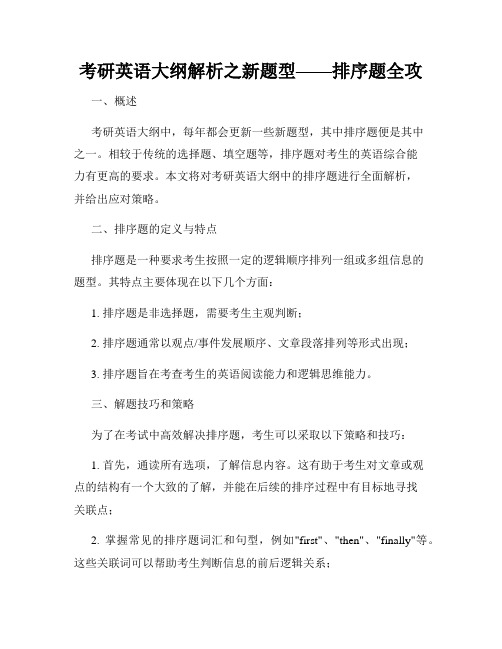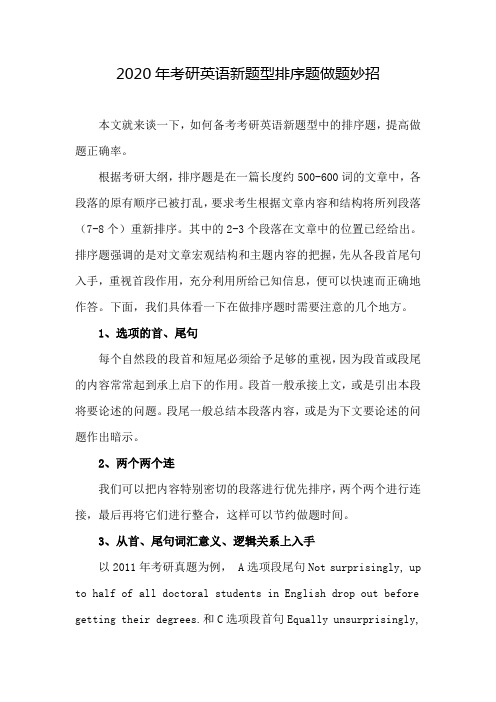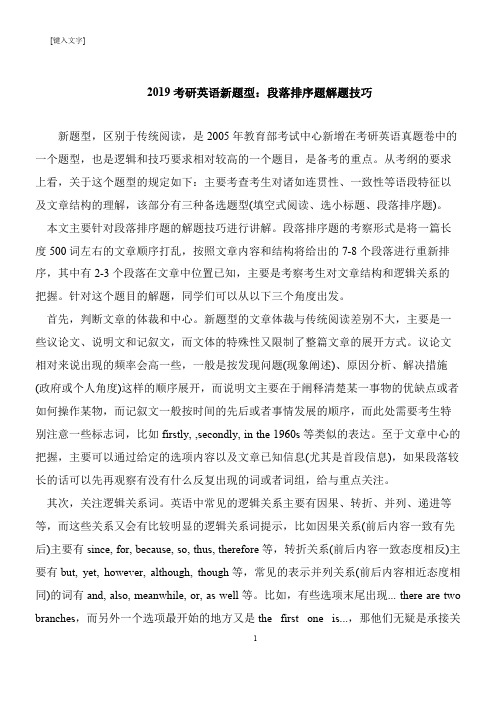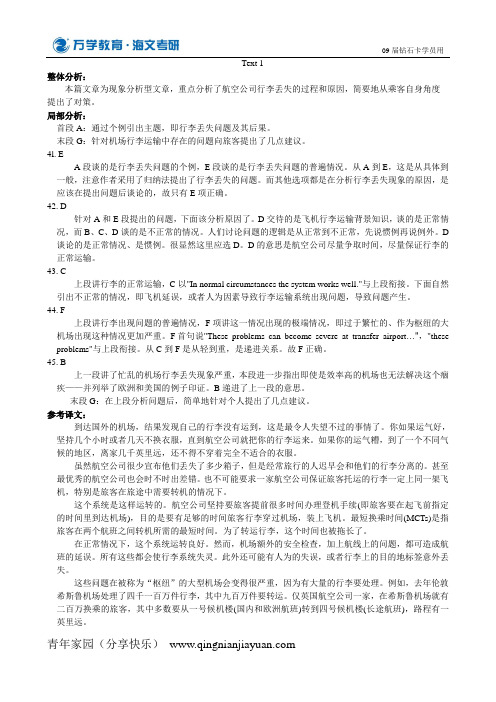新考研英语段落排序题题型解析9
考研英语2010年真题新题型段落排序题解析与答案

[F] For example, wholesale food and drink sales came to $268 billion in France, Germany, Spain, America in 2000 --- more than 40 percent of retail sales. Moreover, average overall margins are higher in wholesale than in retail ; wholesale demand from the food service sector is growing quickly as more Europeans eat out more often ;and in the competitive dynamics of this fragmented industry are at last man it feasible for wholesalers to consolidate.
六. 参考答案:41---45 【B】【F】【D】【G】【A】。
[E] Despite variations in detail, wholesale markets in the countries that have been closely examined---France, Germany—are made out of the same building block. Demand mainly from two sources: in dependent mom—and –pop grocery stores which, unlike large retail chains, are too small to buy straight when they don’t eat at home. Such food service operators, but most of these businesses are known in the trade as “horeca”:hotels, restaurant and cafes. Overall, Europe’s wholesale market for food and drink is growing at the same sluggish pace as the retail market, but the figure when assed together, mask too opposing trends.
考研英语大纲解析之新题型——排序题全攻

考研英语大纲解析之新题型——排序题全攻一、概述考研英语大纲中,每年都会更新一些新题型,其中排序题便是其中之一。
相较于传统的选择题、填空题等,排序题对考生的英语综合能力有更高的要求。
本文将对考研英语大纲中的排序题进行全面解析,并给出应对策略。
二、排序题的定义与特点排序题是一种要求考生按照一定的逻辑顺序排列一组或多组信息的题型。
其特点主要体现在以下几个方面:1. 排序题是非选择题,需要考生主观判断;2. 排序题通常以观点/事件发展顺序、文章段落排列等形式出现;3. 排序题旨在考查考生的英语阅读能力和逻辑思维能力。
三、解题技巧和策略为了在考试中高效解决排序题,考生可以采取以下策略和技巧:1. 首先,通读所有选项,了解信息内容。
这有助于考生对文章或观点的结构有一个大致的了解,并能在后续的排序过程中有目标地寻找关联点;2. 掌握常见的排序题词汇和句型,例如"first"、"then"、"finally"等。
这些关联词可以帮助考生判断信息的前后逻辑关系;3. 注意段落间的过渡和信息的呼应。
有时候可以通过判断某个观点在其他句子中是否有相关提及,来确定其在顺序中的位置;4. 利用排除法。
在考试中,如果对某个选项非常有把握其错误,可以优先排除该选项,以减少解题范围;5. 注意选项的具体表达方式。
选项中可能使用了近近义词替换、改变了句子结构等手法,因此考生需要细心辨别选项之间的差异。
四、练习与提高方法为了更好地应对排序题,考生可以进行以下练习与提高方法:1. 阅读大量排序题例题和解析。
通过阅读更多的排序题例题,考生可以熟悉这种题型的特点和解题技巧,并能更好地应用于实际考试中;2. 制定解题策略并进行实操练习。
考生可以根据自己的解题习惯和策略,进行系统性的实操练习,以掌握更高效解题的能力;3. 模拟真实考试场景进行训练。
考生可以在规定的时间内完成一套完整的考试题目,以提高在压力下解题的能力;4. 寻求教师或老师的指导。
考研英语:新题型之排序题解题攻略

2019考研英语:新题型之排序题解题攻略考研英语阅读是大家狠抓的方面,分值高,题目难,相必大家已经被折磨的够呛了。
换个口味,换种心情,今天老师给大家就技巧性非常强的新题型做一解读攻略,以期能够帮助大家搞定2019考研英语新题型。
以2008年考研英语新题型为例。
首先浏览文章内容,通过一系列关键词writing/ draft/ outline/ revise/ page/ paragragh/ sentence等,可以大致得出文章是关于初稿写作的过程及其中的注意事项。
其次浏览选项,勾画出其中的专有名词、连接词、起始句,并要注意其中的代词是有所指的。
最后结合文章的语义、逻辑、语境、结构关系进行分配,由易而难进行。
首段41题前一句话是说你只有开始写才会有样稿出来,41题后也就是下一段出现了outline,因此浏览选项,只有D句开始说到只有开始写才会起作用,后边说到你要开始具化你的outline了。
衔接非常紧密,因此选的是D选项;42题前一句出现了draft,后一句在说写作过程中出现的需要修改的包括语法、拼写等的错误。
而对应的选项G前部分说draft可以引导写作,末句写不要指望第一遍的样稿是完美无误的;第三段末出现on the other side,因此之前肯定出现on one side,浏览选项,A选项末是one side of the paper,因此这个很容易选出来;44题后一句有代词these printouts,因此44题对应的选项应该与print相关,正好选项C中关键词有两次出现print,因此选项也非常肯定选出;涉及到专有名词The AP,只有在第五段出现,并且要在五段末尾选择一个选项,而E和F选项中均有提及专有名词,需排除一个。
五段是在说可以把一些与主题不相关的不必要的内容删除,然后专有名词是个例子来论证,在段末应该是对这一例子的总结并且与该段段意相关,E在说该例子是与主题不相关的,很容易排除F选出E。
2020年研究生考试英语新题型排序题做题妙招

2020年考研英语新题型排序题做题妙招本文就来谈一下,如何备考考研英语新题型中的排序题,提高做题正确率。
根据考研大纲,排序题是在一篇长度约500-600词的文章中,各段落的原有顺序已被打乱,要求考生根据文章内容和结构将所列段落(7-8个)重新排序。
其中的2-3个段落在文章中的位置已经给出。
排序题强调的是对文章宏观结构和主题内容的把握,先从各段首尾句入手,重视首段作用,充分利用所给已知信息,便可以快速而正确地作答。
下面,我们具体看一下在做排序题时需要注意的几个地方。
1、选项的首、尾句每个自然段的段首和短尾必须给予足够的重视,因为段首或段尾的内容常常起到承上启下的作用。
段首一般承接上文,或是引出本段将要论述的问题。
段尾一般总结本段落内容,或是为下文要论述的问题作出暗示。
2、两个两个连我们可以把内容特别密切的段落进行优先排序,两个两个进行连接,最后再将它们进行整合,这样可以节约做题时间。
3、从首、尾句词汇意义、逻辑关系上入手以2011年考研真题为例, A选项段尾句Not surprisingly, up to half of all doctoral students in English drop out before getting their degrees.和C选项段首句Equally unsurprisingly,only about half end up with professorships for which they entered graduate school.有两个表述需要注意,这就是not surprisingly和equally unsurprisingly,它们在语义上是顺承的关系,段落主要内容都是人文学科专业化所产生的问题。
所以它们应该连在一起,而且是AC排序。
4、如何确定首段排序题最需注意首段,因为首段会告诉我们文章要谈论的内容。
但是,有时为了增加考试难度,首段的位置往往不会告知。
【考研必读】2019考研英语新题型:段落排序题解题技巧

[键入文字]2019考研英语新题型:段落排序题解题技巧新题型,区别于传统阅读,是2005年教育部考试中心新增在考研英语真题卷中的一个题型,也是逻辑和技巧要求相对较高的一个题目,是备考的重点。
从考纲的要求上看,关于这个题型的规定如下:主要考查考生对诸如连贯性、一致性等语段特征以及文章结构的理解,该部分有三种备选题型(填空式阅读、选小标题、段落排序题)。
本文主要针对段落排序题的解题技巧进行讲解。
段落排序题的考察形式是将一篇长度500词左右的文章顺序打乱,按照文章内容和结构将给出的7-8个段落进行重新排序,其中有2-3个段落在文章中位置已知,主要是考察考生对文章结构和逻辑关系的把握。
针对这个题目的解题,同学们可以从以下三个角度出发。
首先,判断文章的体裁和中心。
新题型的文章体裁与传统阅读差别不大,主要是一些议论文、说明文和记叙文,而文体的特殊性又限制了整篇文章的展开方式。
议论文相对来说出现的频率会高一些,一般是按发现问题(现象阐述)、原因分析、解决措施(政府或个人角度)这样的顺序展开,而说明文主要在于阐释清楚某一事物的优缺点或者如何操作某物,而记叙文一般按时间的先后或者事情发展的顺序,而此处需要考生特别注意一些标志词,比如firstly, ,secondly, in the 1960s等类似的表达。
至于文章中心的把握,主要可以通过给定的选项内容以及文章已知信息(尤其是首段信息),如果段落较长的话可以先再观察有没有什么反复出现的词或者词组,给与重点关注。
其次,关注逻辑关系词。
英语中常见的逻辑关系主要有因果、转折、并列、递进等等,而这些关系又会有比较明显的逻辑关系词提示,比如因果关系(前后内容一致有先后)主要有since, for, because, so, thus, therefore等,转折关系(前后内容一致态度相反)主要有but, yet, however, although, though等,常见的表示并列关系(前后内容相近态度相同)的词有and, also, meanwhile, or, as well等。
新考研英语段落排序题题型解析9

考研英语段落排序题题型解析一解题理论分析:名词主体论---结构决定论名词主体论:段落的主要内容和大意体现在段落的主题句中,而且,句子的内容体现在句子的主语、宾语主体上。
因此,为了提高解题效率,考生可以通过句子的主语和宾语的名词把握句子、段落或篇章的含义。
即,名词主体论。
结构决定论:段落排序题的文章结构特点与阅读理解大体一致,一般来说,有六种相对固定的结构形式。
因此,在利用名词主题论理解每个段落内容之后,可以利用文章结构,将段落准确排序。
常见的文章结构顺序包含:一. 议论文1.议题---问题---原因---对策2.议题---问题---对策---结论(未来)3.议题---问题---对策---结论(过去)4.反面话题---驳斥观点---原因---观点—展望未来二. 说明文1.积极事物---优点---缺点---展望未来2.消极事物---缺点---优点---回顾过去三. 叙事文按照时间先后顺序排序。
包含时间,时态和动作。
解题步骤分析:步骤一、理解给定的段落确定文章的文体与结构。
理解给定的段落内容(段落中间有转折词,看转折词所在句;无转折词看段首句、第二句,有时包含段尾句),重点关注动作内容。
步骤二、理解供排序的段落确定段落的内容方向。
理解供排序段落内容(段落中间有转折词,看转折词所在句;无转折词看段首句、第二句,有时包含段尾句),重点关注动作内容。
步骤三、按照文章结构及段落内容准确排序。
利用文章结构,结合以各个段落的内容,准确将段落排序。
解题实战练习:Directions:The following paragraphs are given in a wrong order. For Questions 41—45, you are required to reorganize these paragraphs into a coherent article by choosing from the list A—E to fill in each numbered box. The first and the last paragraphs have been placed for you in Boxes. Mark your answers on ANSWER SHEET 1. (10 points)[A] “I just don’t know how to motivate them to do a better job. We’re in a budget crunch and I have absolutely no financial rewards at my disposal. In fact, we’ll probably have to lay some people off in the near future. It’s hard for me to make the job interesting and challenging because it isn’t —it’s boring, routine paperwork, and there isn’t much you can do about it.“Finally, I can’t say to them that their promotions will hinge on the excellence of their paperwork. First of all, they know it’s not true. If their performance is adequate, most are more likely to get promoted just by staying on the force a certain number of years than for some specificoutstanding act. Second, they were trained to do the job they do out in the streets, not to fill out forms. All through their career it is the arrests and interventions that get noticed.[C] “I’ve got a real problem with my officers. They come on the force as young, inexperienced men, and we send them out on the street, either in cars or on a beat. They seem to like the contact they have with the public, the action involved in crime prevention, and the apprehension of criminals. They also like helping people out at fires, accidents, and other emergencies.[D] “Some people have suggested a number of things like using conviction records as a performance criterion. However, we know that’s not fair — too many other things are involved. Bad paperwork increases the chance that you lose in court, but good paperwork doesn’t necessarily mean you’ll win. We tried setting up team competitions based on the excellence of the reports, but the guys caught on to that pretty quickly. No one was getting any type of reward for winning the competition, and they figured why should they labor when there was no payoff.[E] “The problem occurs when they get back to the station. They hate to do the paperwork, and because they dislike it, the job is frequently put off or done inadequately. This lack of attention hurts us later on when we get to court. We need clear, factual reports. They must be highly detailed and unambiguous. As soon as one part of a report is shown to be inadequate or incorrect, the rest of the report is suspect. Poor reporting probably causes us to lose more cases than any other factor.[F] “So I just don’t know what to do. I’ve been groping in the dark in a number of years. And I hope that this seminar will shed some light on this problem of mine and help me out in my future work.”[G] A large metropolitan city government was putting on a number of seminars for administrators, managers and/or executives of various departments throughout the city. At one of these sessions the topic to be discussed was motivation -- how we can get public servants motivated to do a good job. The difficulty of a police captain became the central focus of the discussion.Order:G--41--42--43--44--45--F步骤一、理解给定的段落确定文章的文体与结构。
考研英语排序题真题答案

考研英语排序题真题答案在考研英语阅读理解部分,排序题要求考生根据文章的逻辑顺序,将打乱的段落重新排列。
以下是一篇排序题的真题及答案解析:原文段落:A. However, the majority of the population still relies on traditional methods for their daily transportation.B. In recent years, the use of electric vehicles has become increasingly popular.C. The introduction of electric buses has significantly reduced the carbon footprint in some cities.D. Despite the advancement in technology, there has been a slow adoption of electric vehicles.E. The government has been promoting the use of electric vehicles through various incentives.F. The transition from traditional to electric vehicles is not without its challenges.正确排序:B, E, C, D, A, F答案解析:1. B - 段落B作为开头,引出主题,即近年来电动车的流行。
2. E - 段落E紧接着B,说明政府如何通过激励措施来推广电动车的使用。
3. C - 段落C进一步阐述了电动车带来的积极影响,即减少碳足迹。
4. D - 段落D转折,指出尽管技术进步,但电动车的普及仍然缓慢。
5. A - 段落A进一步解释了D中提到的慢速普及的原因,即大多数人仍然依赖传统交通方式。
考研英语(一)第三部分新题型:排序、总结、句子匹配

考研英语(一)第三部分新题型:排序、总结、句子匹配(江南博哥)第一节排序材料题根据下面资料,回答1-5题A.Is there still a place for the tiddlers? "That's an explicit yes," says Bob Shea of NACUBO, "do there need to be mergers and acquisitions? That's an unequivocal yes as well." Many small colleges serve niche markets, including a large faith-based one. "Many students wouldn't go to college at all or would be lost in a large one," says Ms. Brown.B.Part of the problem, at least for small liberal arts institutions, is that parents and would-be students are questioning the value of the liberal arts. They want a solid return, in the form of a well-paying job, for their four-year investment. There are still an awful lot of small places:about 40% of degree-granting colleges have fewer than 1,000 students. But enrolment at these institutions has fallen by more than 5% since 2010, while the student population has increased overall.C.Some tiny colleges rely on donations to save the day. Alumni are concerned about the value of their own degree if the college closes, but donors can grow weary. Marlboro, meanwhile, is using its endowment to offer scholarships to one student from each state in an effort to expand its usual pool from New England and to open up new student pipelines. It saw success straight away. It increased its student population by 6% this academic year, after years of falling enrolment.D.Visitors stand out at Marlboro College's pastoral campus in the woods of Vermont, but not because they are special or even unexpected. With 190 enrolled students and just a few dozen faculty and staff, everyone knows everyone. The student-faculty ratio is five to one, about the lowest in the country. The college administration has worked hard to stay small:the student population has rarely topped 350. But in the years since its founding after the Second World War, Marlboro has often skirted financial ruin. In 1993 it had only a few payrolls left in the bank. It was rescued by a foundation. Today it is looking for ways to save itself and already seeing some success.E.To attract students, some colleges are reducing their sticker price, but this is not sustainable for colleges without healthy endowments. According to the National Association of College and University Business Officers (NACUBO), 49% of independent colleges and universities give discounts, up from 38% a decade ago. F.Alice Brown, a former head of the Appalachian College Association, a network of tiny colleges in the Appalachian Mountains, thinks more must merge or close. The Berkeley College of Music (4,371 students) and the Boston Conservatory (730 students) merged in June. Small colleges often share accountants or laboratories already.G.Marlboro is not alone in facing revenue and enrolment pressures. Burlington College(70 students), also in Vermont, shut its doors over the summer. Sweet Briar, a well-regarded women's college in Virginia, nearly closed to its 245 students last year.A last minute bout of fundraising by alumni saved it, for now. Moody's, acredit-ratings agency, said in 2015 that the pace of closures and mergers willaccelerate and could triple from an average of five per year over the next few years. Dennis Gephardt of Moody's says closures and mergers will be concentrated among the smallest colleges.1 [单选题]第(41)题选_______A.AB.BC.CD.DE.EF.FG.G正确答案:G参考解析:第一段谈到了,万宝路学院的基本情况,重点介绍了万宝路学院一直努力保持学院规模小型化:学生人数很少超过350人。
英语考研排序题真题及答案

英语考研排序题真题及答案英语考研的排序题是一种常见的题型,它要求考生根据给定的段落或句子,将其正确地排序,以恢复文章的逻辑顺序。
这类题目考察考生对英语文章结构、逻辑关系以及上下文连贯性的理解能力。
真题示例:1. A. However, the new findings suggest that the impact ofthe virus on the brain is not as severe as previously thought.2. B. But the researchers also found that the virus can cause some damage to the brain.3. C. The latest study on the virus has revealed some interesting results.4. D. In fact, the virus can cause no damage to the brain at all.5. E. This is a significant discovery because it changes our understanding of the virus's effects.答案:3-B-A-E-D解析:- 首先,C句作为首句,引出了研究的主题,因此是第一句。
- 接着,B句中的"but"表明它与前文有转折关系,而A句中的"However"与"the new findings"呼应,说明B和A是紧密相连的,且B在A之前。
- E句中的"This is a significant discovery"是对前文的总结,因此它应该在A句之后。
- 最后,D句中的"In fact"进一步强调了E句中的发现,所以D是最后一句。
英语考研12篇排序题答案

Text 1整体分析:本篇文章为现象分析型文章,重点分析了航空公司行李丢失的过程和原因,简要地从乘客自身角度提出了对策。
局部分析:首段A:通过个例引出主题,即行李丢失问题及其后果。
末段G:针对机场行李运输中存在的问题向旅客提出了几点建议。
4l. EA段谈的是行李丢失问题的个例,E段谈的是行李丢失问题的普遍情况。
从A到E,这是从具体到一般,注意作者采用了归纳法提出了行李丢失的问题。
而其他选项都是在分析行李丢失现象的原因,是应该在提出问题后谈论的,故只有E项正确。
42. D针对A和E段提出的问题,下面该分析原因了。
D交待的是飞机行李运输背景知识,谈的是正常情况,而B、C、D谈的是不正常的情况。
人们讨论问题的逻辑是从正常到不正常,先说惯例再说例外。
D 谈论的是正常情况、是惯例。
很显然这里应选D。
D的意思是航空公司尽量争取时间,尽量保证行李的正常运输。
43. C上段讲行李的正常运输,C以"In normal circumstances the system works well."与上段衔接。
下面自然引出不正常的情况,即飞机延误,或者人为因素导致行李运输系统出现问题,导致问题产生。
44. F上段讲行李出现问题的普遍情况,F项讲这一情况出现的极端情况,即过于繁忙的、作为枢纽的大机场出现这种情况更加严重。
F首句说"These problems can become severe at transfer airport…","these problems"与上段衔接。
从C到F是从轻到重,是递进关系。
故F正确。
45. B上一段讲了忙乱的机场行李丢失现象严重,本段进一步指出即使是效率高的机场也无法解决这个痼疾——并列举了欧洲和美国的例子印证。
B递进了上一段的意思。
末段G:在上段分析问题后,简单地针对个人提出了几点建议。
参考译文:到达国外的机场,结果发现自己的行李没有运到,这是最令人失望不过的事情了。
2020考研英语新题型之排序题得分之道

2020考研英语新题型之排序题得分之道新题型,即阅读理解B节,主要考查考生对诸如连贯性、一致性等语段特征以及文章结构的理解。
在英语一中具体可分为三种备选题型:完型填句/段、段落排序题、小标题题。
每次考试自备选题型中选取一种进行考查。
新题型在考研英语中比较特别,与传统阅读的解题方法相比,其解题策略更加灵活,所以需要同学们掌握一定的方法。
今天就跟随老师一起学习排序题的解题方法,希望能帮助大家在最后的冲刺阶段快速提分。
1、给出首段的排序题按照首尾呼应的原则,依次排出其他段落。
排的过程中,可以从已知段落切入,找与它衔接紧密的段落,可依据已知段首句往上定位,或依据前面自己推出的段落向下排;如果遇到明显的衔接词,可以根据这些衔接词做排除;做不到一次性排出来,可以先进行组块,有些段一看就觉得应该一个前一个后,就可以先确定它们的连贯关系;利用原词复现/近义复现等现象,比如上段提到某个单词或短语,这个单词或短语再次出现的话基本上就排在其后面。
排完之后要检验,顺读一遍,看思路对不对,每篇文章都有其脉络走向,比如提出问题/分析问题/解决问题,这是一种思路,按某种思路去检验,读不通可能就是填错了。
2、未给出首段的排序题首先排首段,再重复上面的方法。
排首段其实比较容易,因为第一段一般不会转折,不会举例,不会出现代词等,一般也不含有最高级、第一或最后意思的词语,因为首段没有比较的对象。
[A] “I just don't know how to motivate them to do a better job. We're in a budget crunch and I have absolutely no financial rewards at my disposal. In fact, we'll probably have to lay some people off in the near future. It's hard for me to make the job interesting and challengingbecause it isn't—it's boring, routine paperwork, and there isn't much you can do about it.”[B] “Finally, I can't say to them th at their promotions will hinge on the excellence of their paperwork. First of all, they knew it's not true. If their performance is adequate, most are more likely to get promoted just by staying on the force a certain number of years than for some specific outstanding act. Second, they were trained to do the job they do out in the streets, not to fill out forms. All through their career it is the arrests and interventions that get noticed.”[C] “I've got a real problem with my officers. They come on the for ce as young, inexperienced men, and we send them out on the street, either in cars or on a beat. They seem to like the contact they have with the public, the action involved in crime prevention, and the apprehension of criminals. They also like helping people out at fires, accidents, and other emergencies.”[D] “Some people have suggested a number of things like using conviction records as a performance criterion. However, we know that's not fair—too many other things are involved. Bad paperwork increases the chance that you lose in court, but good paperwork doesn't necessarily mean you'll win. We tried setting up team competitions based on the excellence of the reports, but the guys caught on to that pretty quickly. No one was getting any type of reward for winning the competition, and they figured why should they labor when there was no payoff.”[E] “The problem occurs when they get back to the station. They hate to do the paperwork, and because they dislike it, the job is frequently put off or done inadequately. This lack of attention hurts us later on when we get to court. We need clear, factual reports. They must be highly detailed and unambiguous. As soon as one part of a report is shown to be inadequate or incorrect, the rest of the report is suspect. Poor reporting probably causes us to lose more cases than any other factor.”[F] “So I just don't know what to do. I've been groping in the dark in a number of years. And I hope that this seminar will shed some light on this problem of mine and help me out in my future work.”[G] A large metropolitan city government was putting on a number of seminars for administrators, managers and/or executives of various departments throughout the city. At one of these sessions the topic tobe discussed was motivation—how we can get public servants motivated to do a good job. The difficulty of a police captain became the central focus of the discussion.Order:G→ 41. → 42. →43. → 44. → 45. → F答案详解41. 【解析】[C] 按照答题步骤,我们首先应当对已知信息进行研读,即阅读首尾段,归纳语篇的基本结构,找出答题的线索。
2023考研英语排序题大纲样题及制胜方略

2023考研英语排序题大纲样题及制胜方略2023考研英语排序题大纲样题及制胜方略考研英语排序题要求考生将一组段落排序,使其意思通顺。
这就要求考生在阅读各个段落时要把握它们的中心大意,并且将各段的段落大意整合,理清它们之间的逻辑顺序。
下面为考生备考提供2023考研英语排序题大纲样题及制胜方略。
(一) 排序题制胜方略该题型是一个排序题。
要求考生将一组段落排序,使其意思通顺。
这就要求考生在阅读各个段落时要把握它们的中心大意,并且将各段的段落大意整合,理清它们之间的逻辑顺序。
(二) 排序题的解题步骤(1) 仔细阅读已经给出的答案,寻找其中的逻辑关系,并且在卷子上划去已经给出的两个答案。
(2) 阅读选项和原文,确定目的答案的位置。
(3) 通读全文,确定语篇形式,检查答案是否合理。
(三) 大纲样题解析Directions:The following paragraphs are given in a wrong order for Questions 41~45,you are required toreorganize these paragraphs into a coherent article by choosing from the list A~G to fill in each numbered box. The first and the last paragraphs have beenplaced for you in Boxes. Mark your answers on ANSWER SHEET 1.(10 points)[A] I just don?t know how to motivate them to do a better job. We?re in a budget crunch and I have absolutely no financial rewards at my disposal. In fact, we?ll probably have to lay some people off inthe near future. It?s hard for me to make the job interesting and challenging because it isn?t—it?s boring, routine paperwork, and there isn?t much youcan do about it.[B] Finally, I can?t say to them that their promotions will hinge on the excellence of their paperwork. First of all, they know it?s not true.If their performance is adequate, most are more likely to get promoted just by staying on the force a certain number of years than for some specific outstanding act. Second, they were trained to do the job they do out in the streets, not to fill out forms.All through theircareer it is the arrests and interventions that get noticed.[D] Some people have suggested a number of things like using conviction records as a performance criterion. However, we know that?s not fair—too many other things are involved. Bad paperwork increases the chance that you lose in court, but good paperwork doesn?t necessarily mean you?ll win. We tried setting up team petitions based on the excellence of the reports, but the guys caught on to that pretty quickly. No one was getting any type of reward for winning the petition, and they figured why should they labor when there was no payoff.[E] “The problem occurs when they get back to the station. They hate to do the paperwork, and because they dislike it, the job is frequently put off or done inadequately. This lack of attention hurts us later on when we get to court. We need clear, factual reports. They must be highly detailed and unambiguous. As soon as one part of a report is shown to be inadequate or incorrect, the rest of the report is suspect. Poorreporting probably causes us to lose more cases than any other factor.”[F] “So I just don?t know what to do. I?ve been groping in the dark in a number of years. And I hope that this seminar will shed some light on this problem of mine and help me out in my future work.”[G] A large metropolitan city gover____ent was putting on a number of seminars for administrators, managers and/or executives of various departments throughout the city. At one of these sessions thetopic to be discussed was motivation—how we can get public servants motivated to do a good job. The difficulty of a police captain became the central focus of the discussion.Order:G → 41. → 42. → 43. → 44. → 45. → F[题解]这篇样题在7个段落中已给出篇首和篇尾段落在文章的位置。
考研英语新题型之段落排序解题方法

全面学习高等数学的基本知识点,理解基本概念,掌握基本运算方法,为
强化提高打下基础。
16
李擂
《考研经综数学基础讲义》
《经济类联考综合阅卷人核心教程》
高等数学
强化课程,依据考试大纲及历真题介绍分别高等数学、线性代数、概率论
主要知识点,归纳总结命题方向和常见的解题思想,结合强化课,帮助考生
进一步强化解题思路。
写作冲刺
掌握写作大小作文的模版,能利用模版衍生解决应试模版的能力,规范写
作
8
王诚
《考研管综写作冲刺讲义》
写作模考
通过应试技巧的学习,提供写作的速度,发现考试中的问题,及时解决,
提高考试分值
4
王诚
《考研管综写作4套卷》
包含课程:
政治,英语,数学一(数学三)+金融硕士专业课(根据学校的要求不
同,部分学校有经济类联考的课程)
冲刺串讲
各科冲刺串讲,系统串讲各科知识体系,指导考生针对核心考点进行深度
学习。
8
李擂
《考研经综数学冲刺讲义》
《经济类联考综合阅卷人核心预测4套卷》
逻辑冲刺
提高运用各种知识点和逻辑方法解答各种类型的逻辑题的综合能力;消灭
逻辑理解中的盲点和误区;提高解题的速度和正确率
4
饶思中
《考研经综逻辑冲刺讲义》
《经济类联考综合阅卷人考前8天写作大预测》
进一步强化解题思路。
24
李擂
《经济类联考综合阅卷人核心笔记·数学》
《经济类联考综合阅卷人核心笔记·数学》
逻辑强化
熟悉逻辑各题型的特点和表现形式,能熟练地运用各知识点和相关的逻辑
方法解题
16
饶思中
考研英语新题型段落排序题解析

考研英语新题型段落排序题解析笔者英语类考试频道为网友整理研究生管理考试,供大家参考学习。
[A]The first and more important is the consumer’s growing preference for eating out: the consumption of food and drink in places other than hours has risen from about 32 percent of total consumption on 1995 to 35% in 2000 and is expected to approach 38% by 2005. This development is boosting wholesale demand from the food service segment by 4 to 5% a year as the recession is looming large, people are getting anxious. They tend keep a tighter hold on their purse and consider eating at home a realistic alternation。
[B] Retail, sales of food and drink in Europe’s largest markets are at a standstill, leaving European grocery retailers hungry for opportunities to grow. Most leading retails have already tried e-commerce, with limited success, and expansion aboard. But almost all have ignored the big profitable opportunity in their own back yard: thewholesale food and drink trade, which appears to be just the kind of market retailers need。
考研英语新题型-段落排序-题四大解题技巧

考研英语新题型”段落排序”题四大解题技巧
考研英语新题型”段落排序”题四大解题技巧,更多考研英语大纲、考研英语备考经验、考研历真题及答案等信息,请及时关注新题型虽然分值小,但是也不能扬弃它,任何一个得分的机会我们都要起劲争取!加油吧,考研
er!
段落排序是近来考研英语新题型中的一种,主要是挑选一篇五百到六百词汇量的文章,将各段落顺序打乱,要求考生梳理出正确的逻辑关系,将段落排序,主要是在阅读的基础上演变而来,考察考生对文章内部结构和逻辑关系的把握程度。
下面就为大家带来该题型的解题技巧。
阅读给定段落
理解给定的段落内容,了解文章是围绕何话题、何对象展开。
阅读过程中要着重留意一些关键词句,如:段落中间若有转折词,要关注转折词及其所在句子;无转折词则应看段首句、第二句及段尾句;重点关注名词、代词等。
判断文章体裁。
- 1、下载文档前请自行甄别文档内容的完整性,平台不提供额外的编辑、内容补充、找答案等附加服务。
- 2、"仅部分预览"的文档,不可在线预览部分如存在完整性等问题,可反馈申请退款(可完整预览的文档不适用该条件!)。
- 3、如文档侵犯您的权益,请联系客服反馈,我们会尽快为您处理(人工客服工作时间:9:00-18:30)。
考研英语段落排序题题型解析一解题理论分析:名词主体论---结构决定论名词主体论:段落的主要内容和大意体现在段落的主题句中,而且,句子的内容体现在句子的主语、宾语主体上。
因此,为了提高解题效率,考生可以通过句子的主语和宾语的名词把握句子、段落或篇章的含义。
即,名词主体论。
结构决定论:段落排序题的文章结构特点与阅读理解大体一致,一般来说,有六种相对固定的结构形式。
因此,在利用名词主题论理解每个段落内容之后,可以利用文章结构,将段落准确排序。
常见的文章结构顺序包含:一. 议论文1.议题---问题---原因---对策2.议题---问题---对策---结论(未来)3.议题---问题---对策---结论(过去)4.反面话题---驳斥观点---原因---观点—展望未来二. 说明文1.积极事物---优点---缺点---展望未来2.消极事物---缺点---优点---回顾过去三. 叙事文按照时间先后顺序排序。
包含时间,时态和动作。
解题步骤分析:步骤一、理解给定的段落确定文章的文体与结构。
理解给定的段落内容(段落中间有转折词,看转折词所在句;无转折词看段首句、第二句,有时包含段尾句),重点关注动作内容。
步骤二、理解供排序的段落确定段落的内容方向。
理解供排序段落内容(段落中间有转折词,看转折词所在句;无转折词看段首句、第二句,有时包含段尾句),重点关注动作内容。
步骤三、按照文章结构及段落内容准确排序。
利用文章结构,结合以各个段落的内容,准确将段落排序。
解题实战练习:Directions:The following paragraphs are given in a wrong order. For Questions 41—45, you are required to reorganize these paragraphs into a coherent article by choosing from the list A—E to fill in each numbered box. The first and the last paragraphs have been placed for you in Boxes. Mark your answers on ANSWER SHEET 1. (10 points)[A] “I just don’t know how to motivate them to do a better job. We’re in a budget crunch and I have absolutely no financial rewards at my disposal. In fact, we’ll probably have to lay some people off in the near future. It’s hard for me to make the job interesting and challenging because it isn’t —it’s boring, routine paperwork, and there isn’t much you can do about it.“Finally, I can’t say to them that their promotions will hinge on the excellence of their paperwork. First of all, they know it’s not true. If their performance is adequate, most are more likely to get promoted just by staying on the force a certain number of years than for some specificoutstanding act. Second, they were trained to do the job they do out in the streets, not to fill out forms. All through their career it is the arrests and interventions that get noticed.[C] “I’ve got a real problem with my officers. They come on the force as young, inexperienced men, and we send them out on the street, either in cars or on a beat. They seem to like the contact they have with the public, the action involved in crime prevention, and the apprehension of criminals. They also like helping people out at fires, accidents, and other emergencies.[D] “Some people have suggested a number of things like using conviction records as a performance criterion. However, we know that’s not fair — too many other things are involved. Bad paperwork increases the chance that you lose in court, but good paperwork doesn’t necessarily mean you’ll win. We tried setting up team competitions based on the excellence of the reports, but the guys caught on to that pretty quickly. No one was getting any type of reward for winning the competition, and they figured why should they labor when there was no payoff.[E] “The problem occurs when they get back to the station. They hate to do the paperwork, and because they dislike it, the job is frequently put off or done inadequately. This lack of attention hurts us later on when we get to court. We need clear, factual reports. They must be highly detailed and unambiguous. As soon as one part of a report is shown to be inadequate or incorrect, the rest of the report is suspect. Poor reporting probably causes us to lose more cases than any other factor.[F] “So I just don’t know what to do. I’ve been groping in the dark in a number of years. And I hope that this seminar will shed some light on this problem of mine and help me out in my future work.”[G] A large metropolitan city government was putting on a number of seminars for administrators, managers and/or executives of various departments throughout the city. At one of these sessions the topic to be discussed was motivation -- how we can get public servants motivated to do a good job. The difficulty of a police captain became the central focus of the discussion.Order:G--41--42--43--44--45--F步骤一、理解给定的段落确定文章的文体与结构。
理解给定的段落内容(段落中间有转折词,看转折词所在句;无转折词看段首句、第二句,有时包含段尾句),重点关注动作内容。
第G段:A large metropolitan city government was putting on a number of seminars for administrators, managers and/or executives of various departments throughout the city. At one of these sessions the topic to be discussed was motivation -- how we can get public servants motivated to do a good job.利用名词主体论动作决定论提炼信息为:was putting on a number of seminars “举行一系列的论坛”;the topic to be discussed was motivation “供讨论的主题是主动性”. 表明该段叙述“议题”,确定本文是议论文。
步骤二、理解供排序的段落确定段落的内容方向。
理解供排序段落内容(段落中间有转折词,看转折词所在句;无转折词看段首句、第二句,有时包含段尾句),重点关注动作内容。
